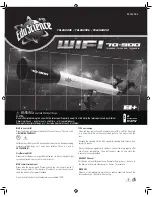
use. Note that the shadow of the secondary mirror is clearly
closer to the “second stage” shadow at the “12 o'clock” position
than at the “6 o'clock” position (blue arrows)
mirror may look thinner in some part and thicker in some other
(red arrows). This is normal, and has no influence on telescope
performance. But the two shadows are now concentric (blue
arrows)
6.
Working on the primary mirror tip-tilt regulation screws, make the figure you see on the wall
symmetric. It may sound weird, but just try to rotate a bit one screw, you will see
immediately how the figure does change. Bring the shadow of the secondary mirror and
the pattern created by the laser to a good level of symmetry. On the wall you can measure
distances between the laser pattern and shadows of different part of the scope using a
simple ruler. That's it! Now proceed to the next step, 6.4B.
6.4B) Primary mirror tip-tilt regulation: star
1. During night, allow the scope to reach thermal equilibrium. How long is needed for this
depends on many factors, but as a rule of thumb, keep the dome open at least 90 minutes
after sunset, and keep the cooling fans running for all that time. Stop the fans before to
proceed. If you use an artificial star you can work in daytime, but respect the minimum
distance between your scope and the artificial star (it should be stated in the instruction
sheet of the artificial star). In general, the farther, the better.
2. Point a bright star, high in the sky (or your artificial star). DO NOT use a 90° prism. You
MUST use a star, a planet cannot be used since it is not a point-like source of light. For the
same reason, there is a minimal distance between the scope and the artificial star.
3. Look at the
defocused
(donuts shaped) star with an eyepiece, starting with the lowest
power available (longest eyepiece focal length). If your optical train does not allow for an
eyepiece to be used, use your camera instead. If this is the case, set the exposure time so
you can appreciate different shades of gray in the star defocused image. Look at it a 100%
zoom minimum (one pixel of the camera is one pixel on your screen); a 200% zoom is
even better.
4. VERY IMPORTANT.
Bring the star in the center of the field of view
and look at a
defocused image. If the image does appear to be “boiling”, and you cannot judge if the
shadow of the secondary mirror is in the center of the white circle (the defocused star),
then your telescope needs some more time to reach ambient temperature, or the seeing is
simply too bad to proceed. Sorry, nobody's fault! You can achieve good collimation only
under “reasonably good” seeing conditions. Perfect collimation requires a perfect seeing.
5. Defocus the star until its size is about ¼ of your field of view. Look the image above. The
dark gray circle is your field of view. The white circle is the defocused star and the black
spot is the position of the secondary mirror's shadow. A collimated scope will look like "A",
above. We omitted the four spokes of the secondary mirror assembly for clarity.
6. If the shadow is not in the middle (in our example, image "B", the shadow is at the "8
o'clock" position) then move the telescope, using the mount motors, so the image goes in
28


































